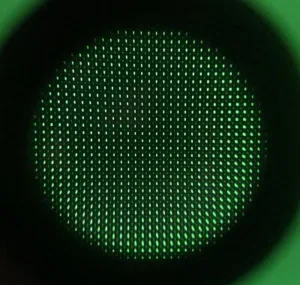In recent years, Samsung has pushed LCD technology forward in a number of ways. One method has been to use a quantum dot film in the stack to expand the color gamut. More importantly, the company has employed advanced LED local dimming systems – with boost mode – in its top LCD TVs to improve control of, and to increase, luminance.

Furthermore, the company has made a number of attempts to improve the viewing angle of VA-type LCD panels – a major challenge. Samsung is certainly not the first company to embark on this mission so why has Samsung, with its latest attempt, seemingly succeeded where others have failed? Well, look a little closer and you will see something quite disturbing.
Here’s the kicker: Samsung’s 8K TVs can’t display 8K resolution and its top 2019 4K TVs can’t display 4K resolution. Unless…
Let’s start from the beginning. In So, When is 8K not 8K – LG has a View!, Bob Raikes explained how Samsung has been using sub-domains and a screen film to improve viewing angles – and how this kills energy efficiency. However, one of the secrets behind Samsung’s ultra-wide viewing angle system actually has its roots in something else. The use of sub-domains is merely an enabler.
Since Samsung introduced its “AI” processor in its 8K TVs – a processor that has trickled down to 4K TVs – its TVs have been using a sub-pixel rendering technique. The goal is to improve viewing angles by taking advantage of sub-domains with liquid crystals pointing in different directions. The company sometimes refers to it as ‘quad rendering’ because it clusters four sub-pixels and operates the ‘quad’ as a group.
From here it gets a little technical and to fully account for the method we would have to cover the differences between IPS and VA, including liquid crystal orientation, and other factors. I would rather use an example. In the example below, the screen was asked to reproduce a specific shade of green (G 96). Seen from this viewing angle (0 degree on-axis), notice how the panel operates its sub-pixels in clusters of four. The upper left is fully lit (G 255), the lower right is dimmed, and the upper right and lower left are turned off. Together, these combine to create the intended shade of green (G 96) – and improves viewing angles. In other types of display panels, each sub-pixel would represent its own gradation so all would display the same G 96 shade.
In other words, the VA LCD panel sacrifices effective resolution to improve viewing angles.
Is this just a theoretic exercise in examining sub-domains under a microscope? No. Once you see it, it is very hard to unsee. In our example, we used green to illustrate the effect but once you feed actual video content to the screen, ‘quad rendering’ gets applied dynamically, depending on the picture composition. In some scenes, there is nothing to see, but in most scenes it is easy to point out, if you know what to look for. Notice the darker areas above her eyes or the darker areas close near the hairline. You will notice lines and pixel patterns. This is an 8K TV so you shouldn’t be seeing these things. That’s because you’re not actually getting 8K resolution with these TVs.
In other scenes you may notice strange patterns near text or lines, or “noise” in color gradations or complex patterns.
In its largest 8K TVs, it appears that Samsung is using a different approach with eight domains, probably because it is easier to fit extra pixels into those larger TVs.
Besides a measurably lower coverage of DCI-P3 color gamut in Samsung’s latest TVs, the dynamic pixel rendering mechanism also affects color reproduction because the panel dims colors/luminance in some sub-pixels, depending on the content. Some scenes have a green tint, mostly visible on grey tones.
The Fun Part
The fun part is that you can easily cross-check how Samsung is applying this dynamic pixel rendering mechanism. That’s because it’s an active system operated by the built-in “AI” processor. Switch to ‘Game’ mode and the system gets deactivated since it would probably increase input lag too much. When you switch on Game mode you will immediately see that viewing angles narrow in. Not a little, but a lot. The system has also been designed to detect test patterns such as 1:1 checkerboard used for benchmarking. It then deactivates dynamic pixel rendering, which is… shady.
CTA recently announced that to meet its 8K TV requirements, an 8K TV “shall meet a minimum of 50% contrast modulation using a 1×1 grill pattern”. Now, I don’t expect Samsung’s already-extensive line-up of 8K TVs to be capable of meeting that requirement. Unless the built-in mechanism designed to defeat test patterns kicks in, of course.
Samsung’s 8K ‘QLED’ LCD TVs can’t display 8K resolution (unless in Game mode), and its 2019 high-end 4K TVs can’t display 4K resolution (unless in Game mode). It’s a significant limitation that seems to have drowned in all of the ‘noise’ surrounding 8K TVs.
One might ask why Samsung is prepared to sacrifice resolution to improve viewing angle? I suppose that the company’s motivation has a lot to do with HDR and its eagerness to position its LCD TVs as the brightest HDR TVs on the market. Poor viewing angles kill HDR for everyone sitting outside the sweet spot. – Rasmus Larsen
Rasmus Larsen is the Editor of flatpanelshd.com, a site focusing on display technology and the TV ecosystem from the consumer viewpoint. It is a resource for news, in-depth articles, technical reviews, and more.



